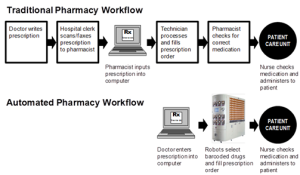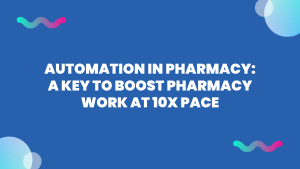Automation is unclosing the new opportunities for the healthcare sector to thrive without hassle. In addition, it eliminates the extreme workload pressure in the healthcare ecosystem, especially in pharmacy stores.
Automation in pharmacy means peace of mind to patients, staff members, and stakeholders.
The real meaning of automation in pharmacy
People think that automation is all about robots taking charge.
But in reality, it’s more than just a robot.
Automation in pharmacy is an advanced system or software solution that automates repetitive tasks to eliminate manual errors, streamline workflows, speed up the process, ensure operational efficiency, and save time, costs, and resources.
Repetitive tasks include
- Manual data entry
- Inventory management
- Prescription refill
- Patient data management
- Billing and accounting
This means the ultimate goal of the pharmacy automation system is to make life easier for pharmacists using robust tech.

A rise of the new era. The lucrative market is the proof itself.
As per the exclusive report from the Globe News Wire, “The Global Pharmacy Automation Market size is valued at USD 5,083 Million in 2021 and is expected to reach USD 10,402 Million by 2030.”
For pharmacies, improving efficiency and accuracy has always been a significant headache.
When we look at the past, the early forms of the automation system were expensive for pharmacies.
But the current scenario is entirely different. Pharmacies can now quickly implement advanced and robust automation software and machines at an affordable expense.
The adoption of automation is rising at a rapid pace in pharmacies or drug stores.
For instance, automated data-entry and dispensing systems, auto-refill, storage, and retrieval systems are standard automation solutions in pharmacies.
Automation has made a positive impact on the productivity, performance, and efficiency of the pharmacy.
The rising demand for lower medication or human errors will drive the entire pharmacy automation market.
How does automation perform in the pharmacy ecosystem? A technical context
The aim is to automate repetitive tasks. So, let’s explore what cooks behind the doors.
1. Tech scenario
RPA (Robotic Process Automation) drives manual workflows in autopilot mode.
It helps in creating and managing software robots.
Software robots are advanced tech solutions that perform tasks just like humans.
For instance, it understands, manages, and completes the data entry process faster and more efficiently.
2. Now, RPA tools are in action
You can’t build or deploy software robots into the pharmacy system without RPA tools.
UiPath (uipath dotcom) is one of the top RPA platforms to build RPA tech to automate repetitive tasks.
After creating a program, you can download it as a .exe file.
But remember, there are two ways – attended and unattended programs.
Attended means a manual start is needed, while unattended, the program automatically starts as per the scheduled time.
3. Now it’s time to install
Install a .exe file into the computer. Now your computer-based repetitive task is in autopilot mode, just like Tesla.
Pharmacy areas that are experiencing the positive outcomes of the automation
One can automate the following computer-based repetitive tasks in the pharmacy.
- Auto-refill to reduce the hassle of patients’ calls and text messages
- Automated inventory management to avoid the headache of the time-consuming and costly processes
- Automatic billing and invoicing to eliminate tedious procedures and manual errors
- Email and SMS automation to notify the patients about their refills and other things
- Automated pharmacy management to keep everything under the same roof
- Automated patient data tracking system
- Remote dispensing system
Automation brings happiness in the true sense
Automation opens endless possibilities for patients, pharmacy staff, and stakeholders to eliminate their headaches with ease.
- Efficient and streamlined workflows
- It makes the pharmacy ecosystem faster and more flexible
- Allows pharmacists to focus on other key areas
- Humans make mistakes. Automation doesn’t
- It improves the work productivity of the staff.
- Reduces the patient data management hassle
- Helps in avoiding the mess of the inventory management
- Auto-refills prescriptions that save time and resources
- Improves patient care experience and satisfaction
- Eliminates the human errors that enhance the patient safety
- Faster and efficient communication
- Ensures operational efficiency
- Improves the accuracy of the workflows
Technologies in the automation systems
1. RPA (Robotic Process Automation):
We both are familiar with how RPA is becoming a helping hand for the pharmacy. It reduces the work burden of the staff and gives them peace of mind in the true sense.
But there are still limitations of the RPA.
It cannot think for itself and performs the task based on the analysis. This means it performs input for the fixed output.
In addition to this, it also requires well-structured data to perform tasks more efficiently.
2. OCR (Optical Character Recognition):
OCR has emerged as the revolutionary tech solution in almost every sector.
The advanced technology automatically extracts the data from the image, PDF, and written text and converts it into a readable and editable format.
Automating the prescription ordering process is one of the drug store’s most common use cases of OCR.
However, it also needs a well-structured data formation to give an accurate output.
3. Artificial Intelligence:
With zero doubt, AI is now an integral part of the entire healthcare ecosystem.
From improving patient care experience to reducing the burnout of the clinical staff, AI in healthcare has shown positive results in almost every corner.
AI enables the pharmacies to make data-driven decisions and automate manual tasks such as personalized messages to patients etc.
What makes it exceptional from the rest is that AI holds the potential to think for itself for the given task or change in the output.
Lastly, an AI-based OCR system also helps get the ideal outcome even from the unstructured data format.
The future of the pharmacy automation
The pharmacy market is experiencing a growing trend of automation adoption.
RPA, AI, OCR, and ML are creating new opportunities in almost every inch of the pharmacy.
But still, pharmacists are performing double-checking systems on the prescription as automation is still in development.
However, the advancement of these technologies in pharmacy app development and software development has the potential to bring 100% accuracy in the next few years.
More importantly, AI harnesses the true power of big data that allows pharmacists to analyze risk patterns.
Here are some of the future needs for automation in pharmacy.
- Faster and more efficient medication dispensing
- More effective and outcome-driven patient data management
- Better management system for the inventory and resources
- 100% accuracy in the repetitive tasks
To sum it up
Automation is bringing flexibility, scalability, and affordability into the pharmacy sector.
It adds result-driven value to the everyday task of the pharmacy team by allowing them to keep an eye on the other vital aspects of the ecosystem.
As a result, pharmacies can now achieve their business goals without compromising costs, labor, and time.
The aim is to bring magic into the life of the patients, pharmacists, and stakeholders, and automation is doing wonders for the same.
The post Automation in Pharmacy: A Key to Boost Pharmacy Work at 10X Pace appeared first on ReadWrite.


Comentarios recientes